#Video Encoder Market
Explore tagged Tumblr posts
Text
North America Video Encoder Market is expected to grow at a CAGR of 2.88% during the forecast period. North America Video Encoder Market is expected to reach US$ 785.22 Bn. by2027.
0 notes
Text
Repurpose content Editor. If you want this services knock in there. https://www.fiverr.com/s/9QrAbA
#100 days of productivity#marketing#video editing#memes#my art#notes#video effects#video encoding#video essay
0 notes
Note
tell me about your defense contract pleage
Oh boy!
To be fair, it's nothing grandiose, like, it wasn't about "a new missile blueprint" or whatever, but, just thinking about what it could have become? yeesh.
So, let's go.
For context, this is taking place in the early 2010s, where I was working as a dev and manager for a company that mostly did space stuff, but they had some defence and security contracts too.
One day we got a new contract though, which was... a weird one. It was state-auctioned, meaning that this was basically a homeland contract, but the main sponsor was Philip Morris. Yeah. The American cigarette company.
Why? Because the contract was essentially a crackdown on "illegal cigarette sales", but it was sold as a more general "war on drugs" contract.
For those unaware (because chances are, like me, you are a non-smoker), cigarette contraband is very much a thing. At the time, ~15% of cigarettes were sold illegally here (read: they were smuggled in and sold on the street).
And Phillip Morris wanted to stop that. After all, they're only a small company worth uhhh... oh JFC. Just a paltry 150 billion dollars. They need those extra dollars, you understand?
Anyway. So they sponsored a contract to the state, promising that "the technology used for this can be used to stop drug deals too". Also that "the state would benefit from the cigarettes part as well because smaller black market means more official sales means a higher tax revenue" (that has actually been proven true during the 2020 quarantine).
Anyway, here was the plan:
Phase 1 was to train a neural network and plug it in directly to the city's video-surveillance system, in order to detect illegal transactions as soon as they occur. Big brother who?
Phase 2 was to then track the people involved in said transaction throughout the city, based on their appearance and gait. You ever seen the Plainsight sheep counting video? Imagine something like this but with people. That data would then be relayed to police officers in the area.
So yeah, an automated CCTV-based tracking system. Because that's not setting a scary precedent.
So what do you do when you're in that position? Let me tell you. If you're thrust unknowingly, or against your will, into a project like this,
Note. The following is not a legal advice. In fact it's not even good advice. Do not attempt any of this unless you know you can't get caught, or that even if you are caught, the consequences are acceptable. Above all else, always have a backup plan if and when it backfires. Also don't do anything that can get you sued. Be reasonable.
Let me introduce you to the world of Corporate Sabotage! It's a funny form of striking, very effective in office environments.
Here's what I did:
First of all was the training data. We had extensive footage, but it needed to be marked manually for the training. Basically, just cropping the clips around the "transaction" and drawing some boxes on top of the "criminals". I was in charge of several batches of those. It helped that I was fast at it since I had video editing experience already. Well, let's just say that a good deal of those markings were... not very accurate.
Also, did you know that some video encodings are very slow to process by OpenCV, to the point of sometimes crashing? I'm sure the software is better at it nowadays though. So I did that to another portion of the data.
Unfortunately the training model itself was handled by a different company, so I couldn't do more about this.
Or could I?
I was the main person communicating with them, after all.
Enter: Miscommunication Master
In short (because this is already way too long), I became the most rigid person in the project. Like insisting on sharing the training data only on our own secure shared drive, which they didn't have access to yet. Or tracking down every single bug in the program and making weekly reports on those, which bogged down progress. Or asking for things to be done but without pointing at anyone in particular, so that no one actually did the thing. You know, classic manager incompetence. Except I couldn't be faulted, because after all, I was just "really serious about the security aspect of this project. And you don't want the state to learn that we've mishandled the data security of the project, do you, Jeff?"
A thousand little jabs like this, to slow down and delay the project.
At the end of it, after a full year on this project, we had.... a neural network full of false positives and a semi-working visualizer.
They said the project needed to be wrapped up in the next three months.
I said "damn, good luck with that! By the way my contract is up next month and I'm not renewing."
Last I heard, that city still doesn't have anything installed on their CCTV.
tl;dr: I used corporate sabotage to prevent automated surveillance to be implemented in a city--
hey hold on
wait
what
HEY ACTUALLY I DID SOME EXTRA RESEARCH TO SEE IF PHILLIP MORRIS TRIED THIS SHIT WITH ANOTHER COMPANY SINCE THEN AND WHAT THE FUCK

HUH??????

well what the fuck was all that even about then if they already own most of the black market???
#i'm sorry this got sidetracked in the end#i'm speechless#anyway yeah!#sometimes activism is sitting in an office and wasting everyone's time in a very polite manner#i learned that one from the CIA actually
160 notes
·
View notes
Note
WHY ARE MOVIES GETTING DARKER I AM ON MY KNEES
Ok fuck it let's go. My amateurish opinions on the three biggest mysteries of film: why they're getting darker, less vibrant and harder to hear. As someone who has worked on camera, montaging, effects and animations, colorimetry when I'm allowed, and on one weird occasion, audio (but I'm an enthusiast ok?)
The short answer is because of technology. The long answer is more nuanced
- Why are movies getting darker?
The "official answer" that filmmakers give actually is technology. Digital cameras allow for much more detail with less lighting required. It also allows videographers to play with different light and exposure settings on the go, instead of having to go with the limitations of the pre-bought film's asa and the precalculated ideal settings. Also film is notoriously bad at capturing dark scenes and responsible for much of the graining we see on analog tv and film.
So basically, they claim it's a stylistic choice. Which could be debated, I mean, after at least five years of everyone complaining about poor lighting, you'd think they'd finally give it up.
BUT there's the whole fact that (certain) special effects are generally easier to pull off when the viewer can't see enough to detect any flaws. They require less care and thus are cheaper and faster to produce. Any studio's wet dream.
Less notably, it's easier to work "down" on colorimetry than it is to work "up." Taking away light from a shot is easier than "creating more light", the latter sometimes leading to very "digitally broken" results. It looks bad. Just grab any video and crank the exposure. It looks horrible.
"But what does exposure have to do with color?" Everything!!! Color IS light!!!
Which leads me to the last reason, HDR. Which leads me to one of the reasons why everything looks so dull.
- Why are movies less vibrant?
So. What is HDR? High Dynamic Range refers to technologies that achieve a much wider light variation. And as we established earlier color IS light, okay? So. More light, more color, brought to you at the hand of display technologies such as OLED and microdimming.
These technologies ramp up the price of domestic screens exponentially. This is why you see domestic televisions that are way above the 2000 dollar mark. And then people will say "oh but my low end television supports HDR, so that's not the issue". Yes. Supports. As in supports files encoded in HDR. Doesn't mean that they have the necessary technology to take advantage of it. Yet they get to put the HDR10 label on their product and get in on the newest marketing fad (it's the new 4k dude. Which is the new 3D. You get what I mean)
And since it is the newest fad, then of course filmmakers HAVE to get in on it. I mean, it's more quality, who doesn't want more quality?
me!!! please stop. not everything has to be aimed at high end equipment (more on this when we get to the audio aspect, aren't you excited?). HDR looks like DOGSHIT if your tv isn't actually OLED. And most consumer TV's aren't OLED.
Tech rant over, I assure you that there is a cultural aspect to this. Don't worry, you're not insane. And it probably is related to the clean girl minimalist iOS style UX modest and demure mentality that is advancing on the 2020s. But it is also related to an art medium shift that we've been undergoing since wayy back when. The sixties.
Yes. I'm gonna go there. I'm gonna talk about Star Trek. I'm going to elaborate on my previous slight outrage.
So. Star Trek marks the beginning of a transition from black and white television into color. It also lands on that weird spot where the whole medium of film and television was still figuring out which elements to import from the ancient medium of theater and which were best left behind.
As a result, Star Trek is very theatrical. And color is a good friend of theater, a medium where everything has to be maximized so that the people in row fifty could appreciate the show almost as well as the people on the first row. Color is a good friend of theater: in wardrobe it helps the performers stand out, boosts up the characters' personality traits, etc. And in lighting, it amplifies moods, conveys emotions and atmospheres related to particular scenes.
The version of Star Trek that you can find on streaming these days is considerably altered from the original product, remastered to make it more palatable to our contemporary brains. As a result, many scenes have been visually altered. The following example shows the original master on the left and the remaster on the right

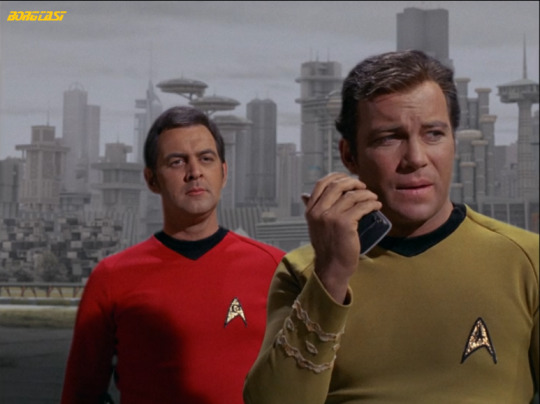
And while at first I held my head in my hands and asked "why, god, why??" The answer is probably that this reads as unserious as fuck. Having the technology now to desaturate scenes and make certain settings look "cloudy", "gritty", "dark and grim," and so on changed the way we perceive colors in regards to mood on modern film and television. This primary color ass setting in today's context reads as goofy, on a scene that is actually meant to impose concern on the viewers. This wouldn't read this way on theater, but it does on television, because we see them as completely separate mediums.
(however I insist that, star trek being a culturally significant show, making these type of creative decisions strips it of its original intent and shits on its cultural value as a window into how they did television in the sixties. so like. fuck you paramount)
Now, television has been getting thematically darker this century (some call it the post-9/11 effect. I wouldn't know. I am latinoamerican) and our palate as viewers has grown more used to these desaturated settings, to the point where seeing something vibrant like the original star trek makes us feel like we're watching a kids show. And not even a modern kids show, more like teletubbies or barney, because have you guys even seen bluey?? It's so... pastel-y.
It's not just HDR. Movies have gotten less vibrant because we're miserable. Sort of. And television and film have grown obsessed with appearing more serious. (Not that sitcoms and comedy movies have ceased to exist, I'm generalizing.)
- But why is dialogue less intelligible?
Official Answer? Technology. Nowadays we are able to capture subtleties in dialogue, so actors don't have to project their voice 24/7, and we can get more intimate dialogue, something almost intended to be a secret that you shouldn't be listening to, making you feel like an intruder. It's the intent.
Unofficially? Technology (marketing fad edition). It's surround audio!!! That's the real culprit!!! And listen, I love surround audio, I have two 5.1 systems at home that we bought secondhand and work like a charm. All that being said: why is star trek tos in 5.1? (YES I'm still on star trek). Why is everything natively encoded in surround audio on streaming these days, left to be down-mixed in real time by your tv?
I'm going to quickly explain surround to y'all using 5.1 as an example. On stereo (which is how most consumers watch film and television) you have two audio channels: your left and right speakers. 5.1 has six: front-left, center, front-right, rear-left, rear-right, and subwoofer. Most dialogue goes through the center speaker. Downmixing is when your tv takes all these channels and mushes them into two: left channel (containing left-front, left rear, center and subwoofer) and right channel (right front, right rear, center and subwoofer). So your center channel is suddenly competing with all these other frequencies and gets a bit muffled.
But wait! It gets worse! 5.1 is now ancient by technology fad standards. For a while there was 7.1 and now the newest, incredibly expensive marketing fad is Dolby Atmos (you might have seen it as a badge on streaming services such as Disney plus). This protocol supports up to 64 channels. You know, if you're crazy and rich enough.
Dolby Atmos was originally developed for cinemas but it's now being sold to direct consumers. According to Dolby, the ideal sound configuration in your home in order to listen to this material the way it was intended from the comfort of your living room is of at least eight (very fancy) speakers and up to 12 speakers.
So. Even with a 5.1 system your audio is still down-mixed.
In conclusion:
Film and television did not get shittier (well, they have, but that's not the sole culprit of this crisis), it just became less accessible and overall uninterested in catering to the average consumer.
22 notes
·
View notes
Text
Apologies for making a bunch of posts about this recently but I think it's important for people to know (and for other people on Tumblr who stream) To give you an idea of how silly Twitch's stance on external vs 'direct' views are - it's nearly impossible to not have more views when posting a link to my stream externally. Whenever I go on Twitch, the front page carousel is dedicated to 3 or 4 huge streamers that play the same game every day. The recommended for you section is only meaningful if you have an account and this makes discoverability is a nightmare. I'm absolutely not blaming anyone who clicks on my streams via Tumblr - it's just utterly shite that Twitch see viewers who click through from external sources as being lesser than someone who searches and clicks on me from Twitch's homepage. That's the excuse they're giving to not grant me Partner status even though I fulfilled all of the requirements. I needed to achieve all of these requirements within a 30 day period and I have busted my gut to make them.

Partner would both help me improve my stream for my viewers with more emotes, priority on Twitch's video encoding, longer storage of my VODs etc as well as help financially when aiming to get sponsored.
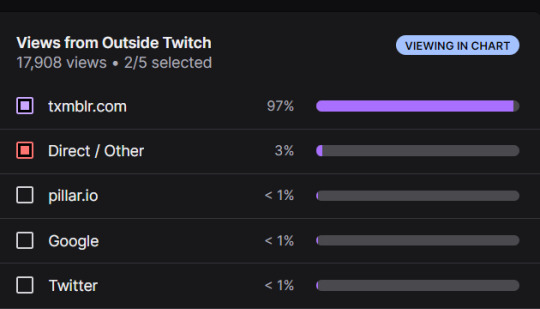
If that 'Direct / Other' percentage doesn't go up that'll keep me locked out of Partner forever. It's just really disappointing, and it forces me to beg people to search for me on Twitch, follow me on Twitch, click the notifications on their phone Twitch apps when I go live. It's so incredibly short-sighted when Twitch is definitely claiming those viewer numbers to market themselves for advertisers.
295 notes
·
View notes
Text
some of you have asked me about my crt setup!!
some basic materials you'll need.
CRT TV (duh)
computer or laptop (duh)
HDMI2AV (NOT AV2HDMI)
RCA cords (the red, white and yellow ones)
HDMI to USB converter if your laptop doesn't have HDMI like mine does.
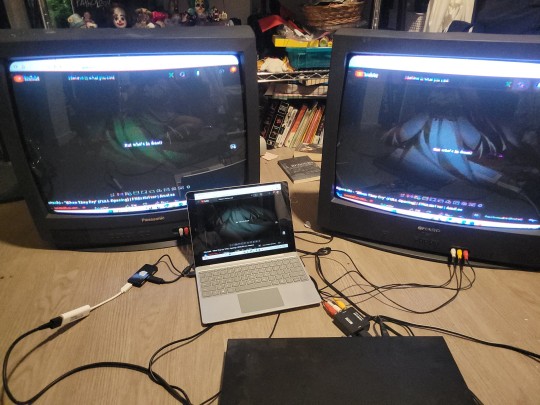
here is the setup, this is a multi monitor setup but you can just do this with one CRT.
step one: plug in your crt. cord in the back. that will power your crt!
step two: plug in the RCA cables like this.
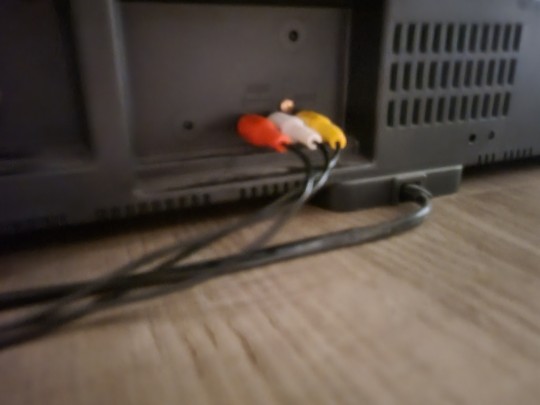
step three: plug your RCA cords into the HDMI2AV adapter like so. you'll plug in an HDMI cord on the other side. MAKE SURE IT'S SET TO THE CORRECT SETTING. THERE'S NTSC AND PAL
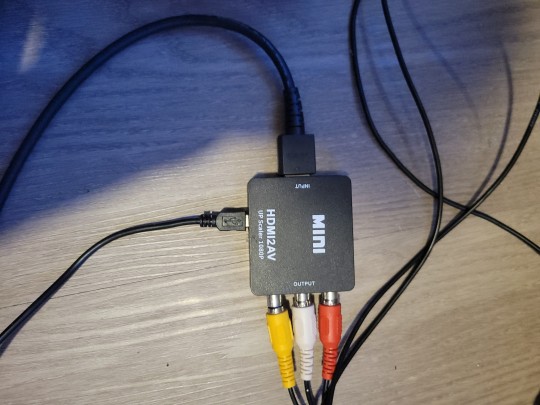
if you don't know what yours is, check this map that explains where each one was sold.
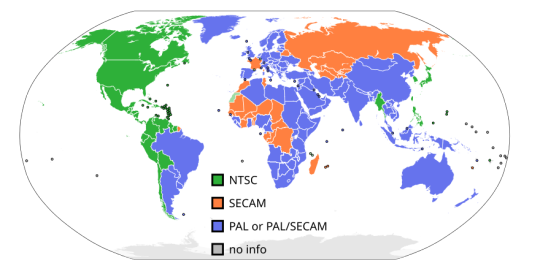
PAL is just a different color encoding system, a bunch of technical stuff you can learn on your own.
step four: plug your HDMI into the USB adapter if you need it. YOU MIGHT NOT. DEPENDS ON YOUR DEVICE.
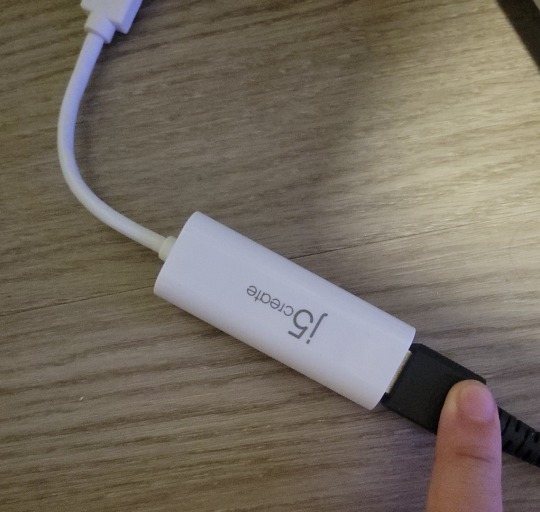
i use a windows surface pro and it requires i use this adapter. sucks ass but whatever.
OPTIONAL: if you have ONLY ONE usb port in your computer, consider getting a USB splitter so you can plug multiple things in. i have one.
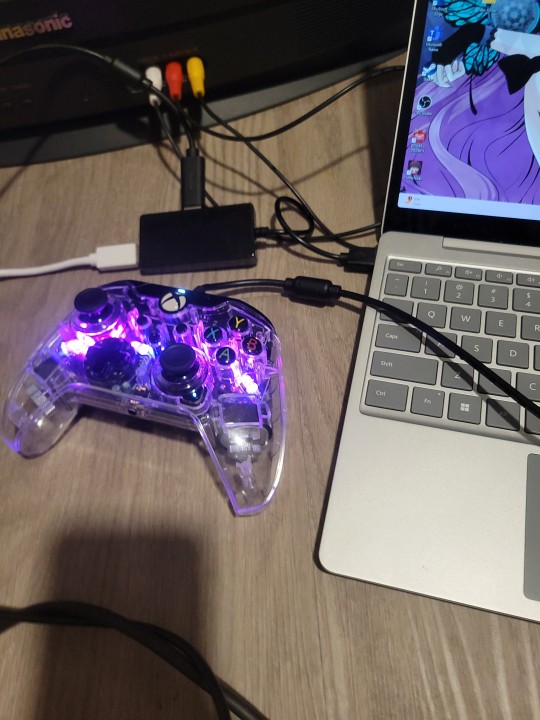
and voila. a set-up!
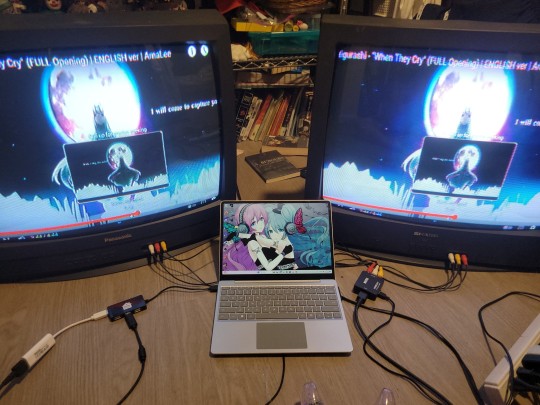
you can treat these like different displays.
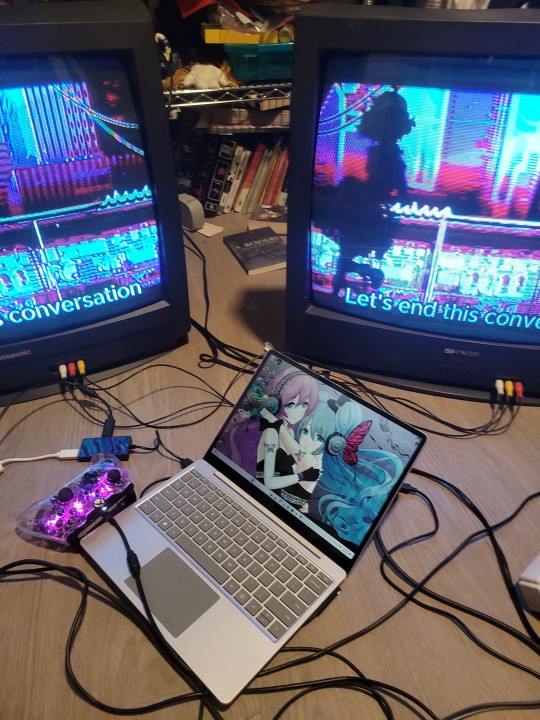
mines connected by the 3 cords in the front, but if you have more money and can get another adapter and etc etc, you can make these all different.
a few FAQ since i assume quite a few of you have never used crts or vhs players:
whats the ringing sound?: its a ringing sound caused by the transformer in the back, its the 15kHz tone. as you get older, you stop hearing it because you lose high frequency hearing. i cant hear it in one ear because of a radio accident and i bursted my eardrum.
can i stop the ringing?: buy a crt pc. theyre smaller and dont ring as much/at all depending on which one you have.
how do i use my vhs player: you plug the cords into the back of the vhs player and then into the crt.
where do i buy a crt: theyre not in production anymore so you will have to buy it secondhand on markets.
where did you get all your cords: most stores with an electronics section will have it but consider secondhand computer parts store.
what do you do with it: literally watch YouTube, vhs tapes, make vhs tapes (whole different thing) or play video games.
can it run bad apple?: yes
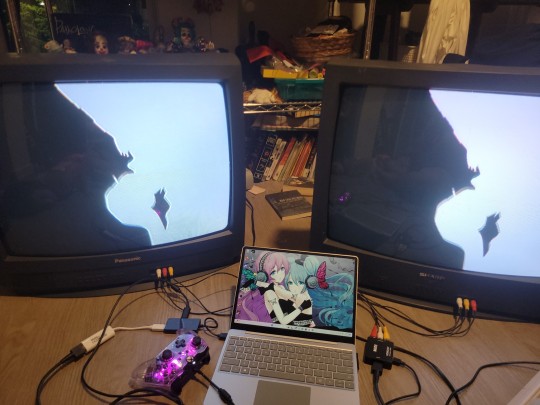
can it run doom?: yes
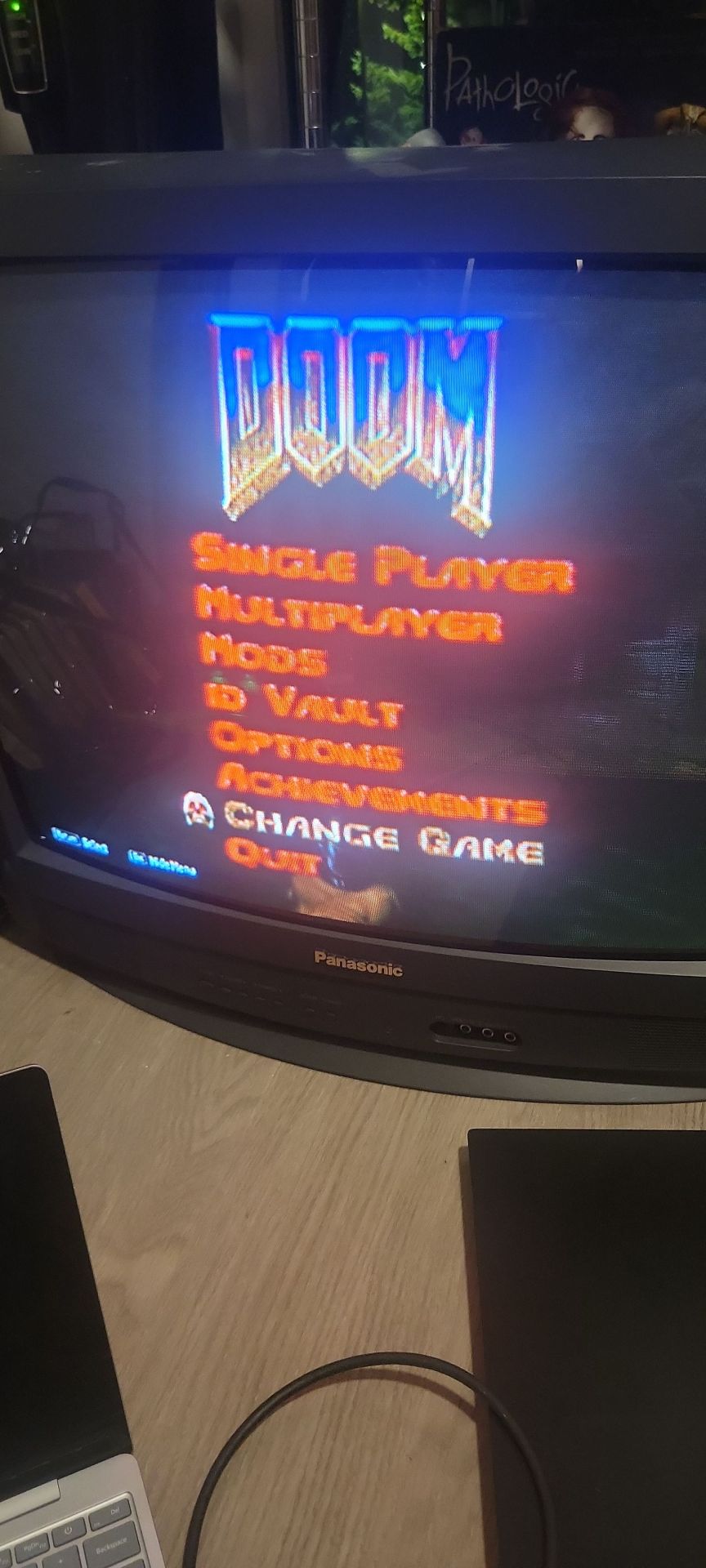
anyways yeah. end tutorial. 🥳
23 notes
·
View notes
Text
DFX452 | Blog Post 4 | 4/15/2025
Wrapping Up Pocket Goblins
Final Logo Fixes and Finishing Touches
After getting some thoughtful peer feedback, I made one last update to the Pocket Goblins logo. A few classmates mentioned the goblins’ hands were blending in too much with their heads, which made them hard to read at first glance.
To fix this, I jumped back into Illustrator and:
Slightly rearranged the goblins' positions
Improved visual clarity while keeping the original design intact
After that, I swapped in the updated logo, re-exported the video through Media Encoder, and locked it in for good.
youtube
Creating the Key Art and Final Shots
With the ad complete, I focused on building supporting visuals and key art to bring the whole project together. I started by taking high-quality screenshots from the finished video and used them to establish a basic visual guideline. For consistency, I decided:
My name would go in the bottom-left corner
The Pocket Goblins logo would stay in the top-right
I returned to Unreal Engine to render new turnarounds of the goblins, using a simple 3-point light setup. I also created a subtle animated turnaround of the treasure chest with the lid gently swaying—bringing back the flowing energy effect I had cut from the final ad. It added a nice finishing touch.




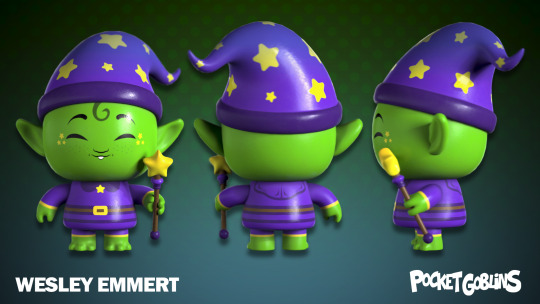
Wireframes and Workarounds
One piece of feedback I kept hearing: show your wireframes. But Unreal’s built-in wireframe material wasn’t ideal—it displays everything in triangles and doesn’t handle animation well.
I wanted animated wireframes in-engine, but due to time and complexity (many pieces per character), I pivoted. Instead, I:
Returned to Maya and used Arnold to render static wireframe images
Used an AO pass underneath to give them subtle depth
Learned the importance of baking wireframes earlier in the process
Was it my original plan? No—but it was a clean, readable solution.
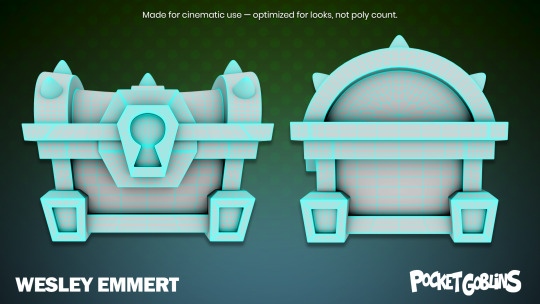
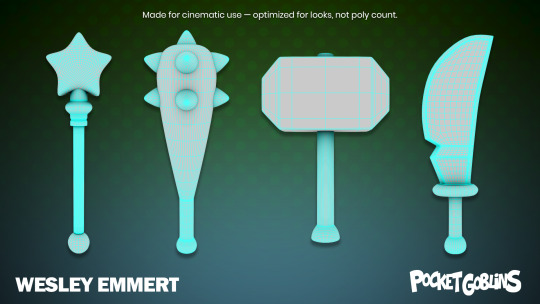




Texture Breakdowns and Extra Content
To round things out, I created texture breakdowns for each goblin and the treasure chest, showcasing the 2048x2048 texture setup used across the board.


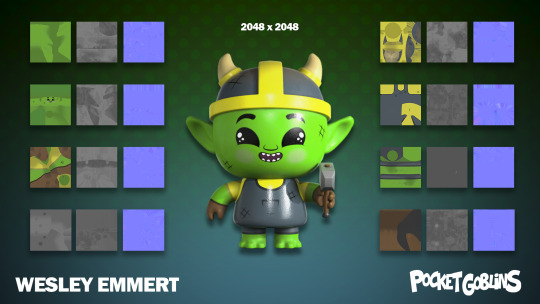

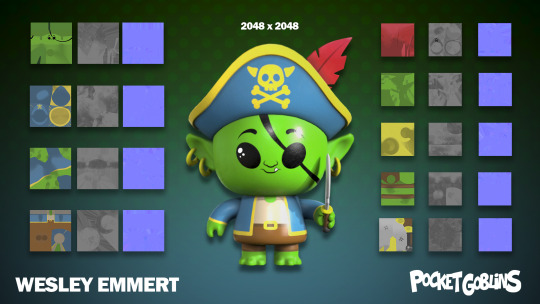
On top of that, I created:
Key art for the Illustrator logo
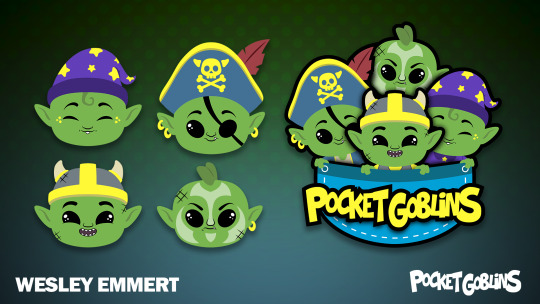
Layouts for the storyboard and early concept art



A fun “Collect Them All!” poster in Photoshop using PNGs from the final video

These final touches gave the project that finished, campaign-ready look I was aiming for.
Upload and Reflection
Once everything was complete, I uploaded the full project to ArtStation.
This project was a major step forward in my CG journey. Compared to my previous work, Board to Death, the growth is clear. That cinematic had no real beauty shots or marketing content—I lacked the confidence and workflow to take it that far at the time.
But with Pocket Goblins, I delivered:
A polished ad
Clean turnarounds
Wireframes, textures, and marketing art
A fully branded presentation
It’s proof that my skills—and my trust in my own process—have grown massively.
What’s Next?
This may be the end of Pocket Goblins, but it’s only the beginning of what’s next. I’ve learned so much through this journey, and I’m more excited than ever to step into the next chapter of my creative work.
Thanks for coming along for the ride.
#pocket goblins#3d art#digital art#stylized 3d#fantasy creatures#character design#goblin design#3d modeling#cg art#substance painter#maya 3d#unreal engine 5#arnold render#fake toy ad#collect them all#toy design#art student life#artstation#render dump#art blog#Youtube
2 notes
·
View notes
Text
The Future of Digital Marketing in 2025 – Trends Every Business Must Adopt
Introduction
As we step into 2025, digital marketing is evolving at an unprecedented pace. Businesses that stay ahead of trends will increase brand visibility, attract more leads, and boost conversions. From AI-driven SEO to hyper-personalized marketing, the digital landscape is more competitive than ever.
Whether you’re a small business owner, entrepreneur, or marketing professional, understanding these trends will help you craft a winning digital marketing strategy. Let’s explore the top digital marketing trends for 2025 that will shape the future of online success.
1. AI-Powered SEO is the Future
Search engines are becoming smarter and more intuitive. With AI-powered algorithms like Google’s MUM (Multitask Unified Model) and BERT (Bidirectional Encoder Representations from Transformers), traditional SEO tactics are no longer enough.
How AI is Transforming SEO in 2025?
✔ AI-driven content creation: Advanced AI tools analyze search intent to create highly relevant, optimized content. ✔ Predictive analytics: AI predicts user behavior, helping businesses optimize content for better engagement. ✔ Voice and visual search optimization: As voice assistants like Siri, Alexa, and Google Assistant become more popular, brands must adapt their SEO strategy to long-tail conversational queries.
Actionable Tip: Optimize for natural language searches, use structured data markup, and ensure website accessibility to improve rankings in 2025.
2. Video Marketing Continues to Dominate
With platforms like TikTok, Instagram Reels, and YouTube Shorts, video marketing is becoming the most powerful form of content in 2025.
Why is Video Marketing Essential?
📌 80% of internet traffic will be video content by 2025 (Cisco Report). 📌 Short-form videos increase engagement and hold attention longer than static content. 📌 Live streaming and interactive videos help brands connect with audiences in real-time.
Actionable Tip: Focus on storytelling, behind-the-scenes content, product demonstrations, and influencer collaborations to boost engagement.
3. Hyper-Personalization with AI & Data Analytics
Consumers expect highly personalized experiences, and AI-powered marketing automation makes it possible.
How Does Hyper-Personalization Work?
✔ AI analyzes customer behavior and past interactions to create tailored marketing messages. ✔ Email marketing campaigns are dynamically personalized based on user interests. ✔ Chatbots and voice assistants provide real-time, customized support.
Actionable Tip: Leverage tools like HubSpot, Salesforce, and Marketo to automate personalized marketing campaigns.
4. Influencer Marketing Becomes More Authentic
The influencer marketing industry is projected to reach $21.1 billion by 2025. However, brands are shifting from celebrity influencers to micro and nano-influencers for better authenticity and engagement.
Why Micro-Influencers Matter?
🎯 Higher engagement rates than macro-influencers. 🎯 More trust & relatability with niche audiences. 🎯 Cost-effective collaborations for brands with limited budgets.
Actionable Tip: Partner with influencers in your niche and use user-generated content (UGC) to enhance brand credibility.
5. Voice & Visual Search Optimization is a Must
By 2025, 50% of all searches will be voice or image-based, making traditional text-based SEO insufficient.
How to Optimize for Voice & Visual Search?
✔ Use long-tail keywords & conversational phrases. ✔ Optimize images with alt text & structured data. ✔ Ensure your site is mobile-friendly and fast-loading.
Actionable Tip: Implement Google Lens-friendly content to appear in image-based search results.
Conclusion
The future of digital marketing in 2025 is driven by AI, personalization, and immersive experiences. If you’re not adapting, you’re falling behind!
Looking for expert digital marketing strategies? Mana Media Marketing can help you grow and dominate your niche. Contact us today!
2 notes
·
View notes
Text
Ideology and Culturalism II: Pop Icons!
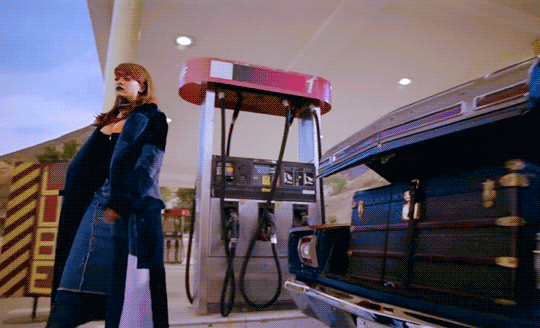
youtube
Rihanna’s music video for “Bitch Better Have My Money” reflects the inner workings of the culture industry through the ideology discussed within the workings of Adorno and Horkheimer. Firstly, to give a general overview of the music video and its role within the culture industry, Rihanna glorifies themes of wealth, power, and materialism–contributing to the ideas of commodification and dependency on economic value. The video begins with kidnapping the wife of a “wealthy” man, as the video progresses, we see Rihanna partaking in luxuries and borderline opulent activities while keeping the woman hostage. Money is at the very center of the music video, from driving a convertible (01:59-01:57), lounging on a yacht (02:48-03-27), to partaking in the usage of drugs and alcohol (03:58-04-26). Adorno and Horkheimer reveal the manipulations within the culture industry–the falsification of profitable “needs.” Adorno and Horkheimer argued that the culture industry manipulates individuals' desires and preferences, the music video profits off the societal desires for success through wealth indicators–reinforcing materialism under a capitalist framework.
This is an industry that idealizes consumerablity to value and gauge the necessity of a product which disturbs the artistic process of creation. All forms of art, from podcast to music video, are subject to the interests of money. While this prioritization of money is explicitly promoted in the lyrics of BBHMM, the song fits the standard mold of creation. There is a repetitive nature within the lyrics, art is then removed from the artist–it becomes a commodified product, transformed and designed for profit. The industry is solely concerned with making profits–this is directly linked to pop culture and everything in between.
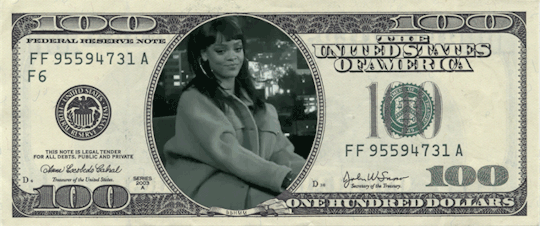
Rihanna, herself, is a pop culture icon that is subject to the means of a mass capitalist consumerist mindset displaced within the music industry. She reflects the timely trends of the time, we can see this through the musical style of the backing track and the stylized outfits from 8 years ago. Down to the makeup trends of a long and thick liner and the neutral but bold lip color, implementing the micro trends of 2015 to mold to what would reel in the masses. The standardized content to capture the interest of the masses to form to contribute to a homogeneous culture of values.
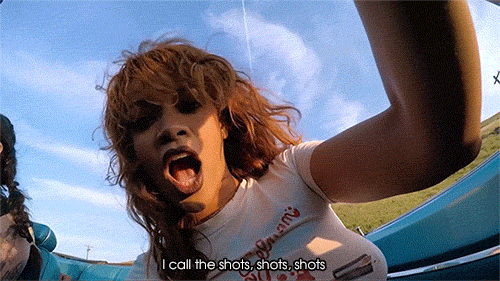
During the process of encoding and decoding, the viewing audience may have varying interpretations of the music video based on their personal experience and background. Some may see the video as a form for women empowerment, the breakdown a male-dominate industry. Rihanna taking control and asserting herself as a force to be reckoned with. Or, others can see this as the glorification of violence as a means of retaining wealth and power. This ties into the commodified rebellion aspect of the culture industry. We as an audience interpret and decode Rihanna as a powerful figure, empowering women for the sake of feminism, but at the same time she is primarily making profit from our sentiment, rather than directly advocating for women.
youtube
"Bitch I’m Madonna", coming out the same year as BBHMM, functions in a similar manner to Rihanna’s work. Both pop star icons, which directly support Adorno and Horkheimer’s beliefs on the culture industry, have been molded into marketable products for mass consumption by the culture industry. The name “Madonna” has become a brand itself, which is apparent in the name of the song! Her image is enhanced through her commercial appeal as a global and legendary celebrity. She also incorporates cameos from different house-hold name celebrities (02:00-02:28) like Beyonce, Kanye, Katy Perry, and Miley Cyrus–highlighting the interconnectedness of fame and strengthening the celebrity culture. Keeping it in the circle, literally, supports the capitalist notions of social status, a notion that Adorno and Horkheimer challenge in their work.
Based on the way the music video was filmed, Madonna features an excess of wealth and luxury through a party-like concept, and is constantly surrounded by glamorous clothing and accessories. By barely having any cuts, almost a one shot, and Madonna as the focal point, the music video carefully crafts a branded image where success is measured by the individual’s own ability to make a name for themselves–promoting a culture of consumption. The flashy visuals, bright colors, and the strong and visually appealing choreography conforms to the ideas found within the culture industry and its expectations of a formulaic, mainstream media piece.

Madonna received a lot of negative criticisms and feedback when premiering her music video back in 2015. The public reception consisted of a lot of people suggesting that Madonna was clawing to stay “relevant” at this time by displaying acts that are typically done by younger folk. Tying this to Stuart Hall’s findings of encoding and decoding, a viewer may receive a message of excessive narcissism within the world of Madonna. In correspondence to Hall’s ideas on oppositional reading, Madonna encodes the music video with her vibrancy and energy, showcasing empowerment for an older generation, but through decoding the message, one might suggest that the focus on materialism is detrimental to the career of the icon. The dynamic nature of decoding supports Stuart Hall's theory, emphasizing the active role of the audience in making meaning from media texts.
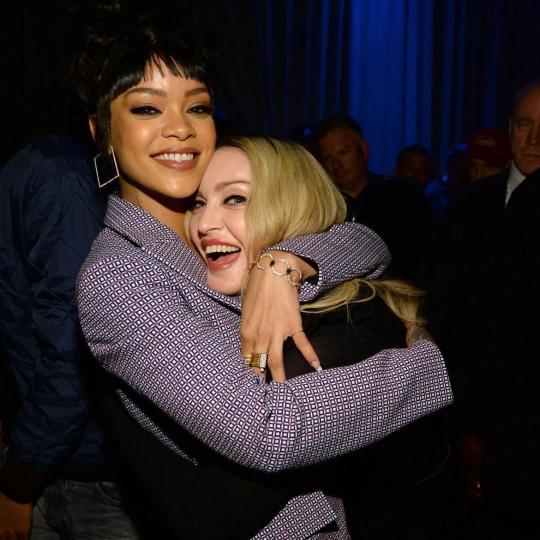
Both iconic women showcase their adaptation to cultural trends of the era in media; due to both celebrities being subject to the culture industry, the use of conformity is a characteristic of the mass production of cultural products–this is also applied to the standardized format commonly found in the music industry that can diminish the artistic integrity found in the careers of both Rihanna and Madonna. Through the use of iconography, an audience may decode both artists’ expressions in the context of social frameworks.
Based on the conceptualization of the culture industry, are there aspects of pop culture that do not fall under the commodification of art?
How does the interplay between the sound and visuals of both Madonna’s “Bitch I’m Madonna” and Rihanna’s “Bitch Better Have My Money” challenge or support each other? How may that influence the process of decoding the messages from the artist?
In what ways is Madonna and Rihanna presented as a marketable commodity in her music videos from now and before, and how does this reflect the commercialization of art discussed by Adorno and Horkheimer’s “The Culture Industry as Mass Deception?
Max Horkheimer and Theodor Adorno, “The Culture Industry: Enlightenment as Mass Deception,” in Dialectic of Enlightenment (California: Stanford University press, 2002)
Stuart Hall, “Encoding, Decoding,” in The Cultural Studies Reader (London: Routledge, 1993)
14 notes
·
View notes
Text
North America Video Encoder Market is expected to grow at a CAGR of 2.88% during the forecast period. North America Video Encoder Market is expected to reach US$ 785.22 Bn. by2027.
0 notes
Text
Share Your Anecdotes: Multicore Pessimisation
I took a look at the specs of new 7000 series Threadripper CPUs, and I really don't have any excuse to buy one, even if I had the money to spare. I thought long and hard about different workloads, but nothing came to mind.
Back in university, we had courses about map/reduce clusters, and I experimented with parallel interpreters for Prolog, and distributed computing systems. What I learned is that the potential performance gains from better data structures and algorithms trump the performance gains from fancy hardware, and that there is more to be gained from using the GPU or from re-writing the performance-critical sections in C and making sure your data structures take up less memory than from multi-threaded code. Of course, all this is especially important when you are working in pure Python, because of the GIL.
The performance penalty of parallelisation hits even harder when you try to distribute your computation between different computers over the network, and the overhead of serialisation, communication, and scheduling work can easily exceed the gains of parallel computation, especially for small to medium workloads. If you benchmark your Hadoop cluster on a toy problem, you may well find that it's faster to solve your toy problem on one desktop PC than a whole cluster, because it's a toy problem, and the gains only kick in when your data set is too big to fit on a single computer.
The new Threadripper got me thinking: Has this happened to somebody with just a multicore CPU? Is there software that performs better with 2 cores than with just one, and better with 4 cores than with 2, but substantially worse with 64? It could happen! Deadlocks, livelocks, weird inter-process communication issues where you have one process per core and every one of the 64 processes communicates with the other 63 via pipes? There could be software that has a badly optimised main thread, or a badly optimised work unit scheduler, and the limiting factor is single-thread performance of that scheduler that needs to distribute and integrate work units for 64 threads, to the point where the worker threads are mostly idling and only one core is at 100%.
I am not trying to blame any programmer if this happens. Most likely such software was developed back when quad-core CPUs were a new thing, or even back when there were multi-CPU-socket mainboards, and the developer never imagined that one day there would be Threadrippers on the consumer market. Programs from back then, built for Windows XP, could still run on Windows 10 or 11.
In spite of all this, I suspect that this kind of problem is quite rare in practice. It requires software that spawns one thread or one process per core, but which is deoptimised for more cores, maybe written under the assumption that users have for two to six CPU cores, a user who can afford a Threadripper, and needs a Threadripper, and a workload where the problem is noticeable. You wouldn't get a Threadripper in the first place if it made your workflows slower, so that hypothetical user probably has one main workload that really benefits from the many cores, and another that doesn't.
So, has this happened to you? Dou you have a Threadripper at work? Do you work in bioinformatics or visual effects? Do you encode a lot of video? Do you know a guy who does? Do you own a Threadripper or an Ampere just for the hell of it? Or have you tried to build a Hadoop/Beowulf/OpenMP cluster, only to have your code run slower?
I would love to hear from you.
13 notes
·
View notes
Text
This Week’s Horrible-Scopes
It’s time for this week’s Horrible-Scopes! So for those of you that know your Astrological Signs, cool! If not, just pick one, roll a D12, or just make it up as you go along. It really doesn’t matter. Better yet! Check out “Heart of the Game, Fredonia” and see if they can sell you those D12’s with the symbols on them. Tell them “Shujin Tribble” sentcha. And “Hail, Hail, Fredonia!” Home of the Blue Devil!
Sooooo…. Theme, right? (*Sigh*) Ok, ok. So once again a theme has been suggested, and I seriously considered how to twist this one around on the requester. So you know what? Santa’s already done his thing and I’m SAFE! That’s exactly what I’m about to do. So with no further ado, here are New Year’s Resolutions no one wants to do.
Aries
You get to set the stage presence here with something known as “Film Academy 2×”. It’s a format specifying an aspect ratio of 1.37:1 that was laid out in the 1930’s because no one could agree on a motion picture technical spec. These days it’s a digital resolution of 1828 × 1332, which is better than any monitor you’ve got right now. So This Week… watch some old Buster Keeton films… and remember, he was the ORIGINAL Jackie Chan for performing stunts!
Taurus
Swinging over the pond and into true weirdness for Television Broadcasting we get to your resolution system: “Undecoded PALplus”. It was a re-do of the PAL broadcast system that brought 16:9 Widescreen broadcasts, but still supported traditional PAL receivers. So This Week… Learn how to add onto your existing knowledge base without breaking what you had already… meaning just read a damned book for a change, would you?
Gemini
A true digital system for once, you’re getting “SVCD” aka the “Super Video CD”. It was a digital movie file, encoded in MPEG-2, and came in one of two varieties: 480i (or 480 pixels square), or 576i (or 480 x 576 pixels). The system came out in 1998 and honestly it’s best use was in early shoot-em-up CD games with video cutscenes to them. So This Week… find your collection of old games and play some again. We’re pretty sure Cookie from You Don’t Know Jack misses you.
Cancer Moon-Child
Another Disk, another digital format. This time it’s the most prolific media adoption in history: the DVD. Bet most of you didn’t know “DVD” stands for “Digital Versatile Disk”. With a MINIMUM storage capacity of over 4 and-a-half Gigs of data, you could backup most computers completely to one of those puppies. But as a movie disk you’re relegated to the venerable standards of NTSC at 480 lines tall, or PAL’s at 576. The system came out in 1996, and these days it’s impossible to find a movie or TV show NOT on this format. So This Week… Just admit that “DVD 3D” is a Dead Format. You bought all that super expensive stuff and now it’s just not worth it. Get over yourself.
Leo
Look at you, Leo! Scammin’ off the pack! More laser disk goodness, but this time you get the “CVD”. That’s not a typo; CVD stands for “China Video Disk” and that’s exactly what it sounds like. It was a way of making video disks without needing to go through the whole SVCD standard. It was close, but lacking in resolution. So This Week… Your ability to run under the Patent Lawyers' radars is impressive. Keep up the good work, but don’t get caught.
Virgo
We know you think you’re superior to everyone else, but that doesn’t mean you’ll succeed in all areas. Your format is “Betacam”, which we’re guessing some of you already kinda know what’s coming. Yes it was as-good or better than VHS for the home market, but for the professionals, it was GREAT! Get a short-play cassette at home, but the Long Play version in the studio, and it was basically The Same Cassette! Sad it got shanked in the end, but sometimes that happens. So This Week… Take some pride in knowing your format may have come out in 1982, but it’s STILL got Technical Support through this past year! 40 Years of Active Duty for a supposedly Failed Format’s pretty damned good in our book!
Libra
Just when we thought the Analogue Film Industry was an anachronism and lost its relevance… just like Michael Corleone they’re pulling us back in again. This time it’s the “Film 8K” format. We’re not dealing with 1.85:1 any more, but with a resolution of 7992 × 4320… and really, WHY?!?! The only reason this is important is if you’re watching this on a freekin’ MASSIVE projection screen! So, good luck with all that on a computer: VLC will CHOKE to death if you’re running a 1440 monitor and a GTX-1660 Super! So This Week… LOSE SOME WEIGHT!
Scorpio
We’re just gunna call it right now. You! ARE! BASIC! White-Bread Toast, generic as hell NTSC. The format that swept North America because 60Hz power signals are just a wonderful way to make sure everyone’s receiver works right. Your format supports both Black and White and Colour receivers without breaking anyone’s machine. So you've got that going for you. So This Week… Try replacing your mayonnaise with Caesar Salad Dressing for a new kick.
Sagittarius
Your format cannot be overstated in how great it was! And, sadly, yes.. “Was”. You need to look up what “Laserdisk” looks like, because, holy HELL, that’s a gorgeous disk. And the output was better than standard NTSC and PAL or SECAM and testing proves this. So This Week… check out Linus Tech Tips on YouTube and see the side-by-side comparison between VHS and Laserdisk, and weep at what we were denied.
Capricorn
You’ve just GOT to be the Odd One Out, huh? Your format is literally called “405-line”. And the fun part about this is it ISN’T 405 scan-lines in format! Nope! It’s KINDA 503 × 377, give or take a little smearing. It’s a monochrome television broadcasting system introduced with the BBC Television Service in 1936, so it’s done well for itself for a while. BUT! In the United States, the FCC had briefly approved a 405-line color television standard in October 1950, which was developed by CBS… only to find out that it was incompatible with existing black-and-white receivers. So This Week… Don’t think of it as “Conforming to the Norm” so much as “Making sure you don’t destroy everyone with your awesomeness.”
Aquarius
Going fully to the WebCam, or PervCam, systems, you’re getting the Video Conference System “CIF”, aka the “Common Interchange Format”. Developed for company teleconferencing it was a low-rez 352 × 288 pixel image, and if you want to know what that looked like, you’ll have to watch a fair adaptation of a great book. So This Week… watch the movie “Contact”. The teleconference windows are JUST what it used to look like.
Pisces
You just HAD to be the personification of annoying A-Hole Cat, huh? Take your pick: VHS, Betamax, or Video8. They all had just CRAP picture quality. About 320 × 486 scans in NTSC, or kinda 310 × 576 in PAL or SECAM, they were all just a cluster of sub-optimal tech sold as just this GREAT stuff, and it really wasn’t. So This Week… Learn what the Sunk Cost Fallacy is and stop falling for all the Wiz-Bang-Shiny-New sales pitches.
And THOSE are your Horrible-Scopes for this week! Remember if you liked what you got, we’re obviously not working hard enough at these. BUT! If you want a better or nastier one for your own sign or someone else’s, all you need to do to bribe me is just Let Me Know - or check out the Ko-Fi page ( https://ko-fi.com/icarusthelunarguard )! These will be posted online at the end of each week via Tumblr, Twitter, Facebook, Discord and BLUESKY.
#parody#horrorscope#funny#horoscope#humor#comedy#nye#new years resolution#happy new year#ball drop#new year#holiday#you don't know jack
5 notes
·
View notes
Text
Genio 510: Redefining the Future of Smart Retail Experiences
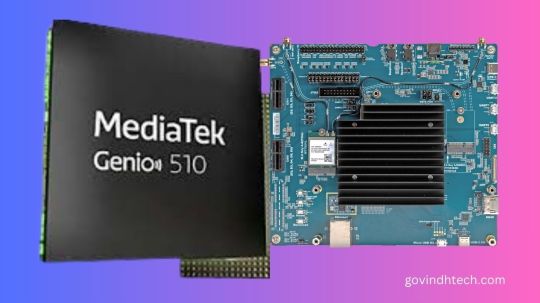
Genio IoT Platform by MediaTek
Genio 510
Manufacturers of consumer, business, and industrial devices can benefit from MediaTek Genio IoT Platform’s innovation, quicker market access, and more than a decade of longevity. A range of IoT chipsets called MediaTek Genio IoT is designed to enable and lead the way for innovative gadgets. to cooperation and support from conception to design and production, MediaTek guarantees success. MediaTek can pivot, scale, and adjust to needs thanks to their global network of reliable distributors and business partners.
Genio 510 features
Excellent work
Broad range of third-party modules and power-efficient, high-performing IoT SoCs
AI-driven sophisticated multimedia AI accelerators and cores that improve peripheral intelligent autonomous capabilities
Interaction
Sub-6GHz 5G technologies and Wi-Fi protocols for consumer, business, and industrial use
Both powerful and energy-efficient
Adaptable, quick interfaces
Global 5G modem supported by carriers
Superior assistance
From idea to design to manufacture, MediaTek works with clients, sharing experience and offering thorough documentation, in-depth training, and reliable developer tools.
Safety
IoT SoC with high security and intelligent modules to create goods
Several applications on one common platform
Developing industry, commercial, and enterprise IoT applications on a single platform that works with all SoCs can save development costs and accelerate time to market.
MediaTek Genio 510
Smart retail, industrial, factory automation, and many more Internet of things applications are powered by MediaTek’s Genio 510. Leading manufacturer of fabless semiconductors worldwide, MediaTek will be present at Embedded World 2024, which takes place in Nuremberg this week, along with a number of other firms. Their most recent IoT innovations are on display at the event, and They’ll be talking about how these MediaTek-powered products help a variety of market sectors.
They will be showcasing the recently released MediaTek Genio 510 SoC in one of their demos. The Genio 510 will offer high-efficiency solutions in AI performance, CPU and graphics, 4K display, rich input/output, and 5G and Wi-Fi 6 connection for popular IoT applications. With the Genio 510 and Genio 700 chips being pin-compatible, product developers may now better segment and diversify their designs for different markets without having to pay for a redesign.
Numerous applications, such as digital menus and table service displays, kiosks, smart home displays, point of sale (PoS) devices, and various advertising and public domain HMI applications, are best suited for the MediaTek Genio 510. Industrial HMI covers ruggedized tablets for smart agriculture, healthcare, EV charging infrastructure, factory automation, transportation, warehousing, and logistics. It also includes ruggedized tablets for commercial and industrial vehicles.
The fully integrated, extensive feature set of Genio 510 makes such diversity possible:
Support for two displays, such as an FHD and 4K display
Modern visual quality support for two cameras built on MediaTek’s tried-and-true technologies
For a wide range of computer vision applications, such as facial recognition, object/people identification, collision warning, driver monitoring, gesture and posture detection, and image segmentation, a powerful multi-core AI processor with a dedicated visual processing engine
Rich input/output for peripherals, such as network connectivity, manufacturing equipment, scanners, card readers, and sensors
4K encoding engine (camera recording) and 4K video decoding (multimedia playback for advertising)
Exceptionally power-efficient 6nm SoC
Ready for MediaTek NeuroPilot AI SDK and multitasking OS (time to market accelerated by familiar development environment)
Support for fanless design and industrial grade temperature operation (-40 to 105C)
10-year supply guarantee (one-stop shop supported by a top semiconductor manufacturer in the world)
To what extent does it surpass the alternatives?
The Genio 510 uses more than 50% less power and provides over 250% more CPU performance than the direct alternative!
The MediaTek Genio 510 is an effective IoT platform designed for Edge AI, interactive retail, smart homes, industrial, and commercial uses. It offers multitasking OS, sophisticated multimedia, extremely rapid edge processing, and more. intended for goods that work well with off-grid power systems and fanless enclosure designs.
EVK MediaTek Genio 510
The highly competent Genio 510 (MT8370) edge-AI IoT platform for smart homes, interactive retail, industrial, and commercial applications comes with an evaluation kit called the MediaTek Genio 510 EVK. It offers many multitasking operating systems, a variety of networking choices, very responsive edge processing, and sophisticated multimedia capabilities.
SoC: MediaTek Genio 510
This Edge AI platform, which was created utilising an incredibly efficient 6nm technology, combines an integrated APU (AI processor), DSP, Arm Mali-G57 MC2 GPU, and six cores (2×2.2 GHz Arm Cortex-A78& 4×2.0 GHz Arm Cortex-A55) into a single chip. Video recorded with attached cameras can be converted at up to Full HD resolution while using the least amount of space possible thanks to a HEVC encoding acceleration engine.
FAQS
What is the MediaTek Genio 510?
A chipset intended for a broad spectrum of Internet of Things (IoT) applications is the Genio 510.
What kind of IoT applications is the Genio 510 suited for?
Because of its adaptability, the Genio 510 may be utilised in a wide range of applications, including smart homes, healthcare, transportation, and agriculture, as well as industrial automation (rugged tablets, manufacturing machinery, and point-of-sale systems).
What are the benefits of using the Genio 510?
Rich input/output choices, powerful CPU and graphics processing, compatibility for 4K screens, high-efficiency AI performance, and networking capabilities like 5G and Wi-Fi 6 are all included with the Genio 510.
Read more on Govindhtech.com
#genio#genio510#MediaTek#govindhtech#IoT#AIAccelerator#WIFI#5gtechnologies#CPU#processors#mediatekprocessor#news#technews#technology#technologytrends#technologynews
2 notes
·
View notes